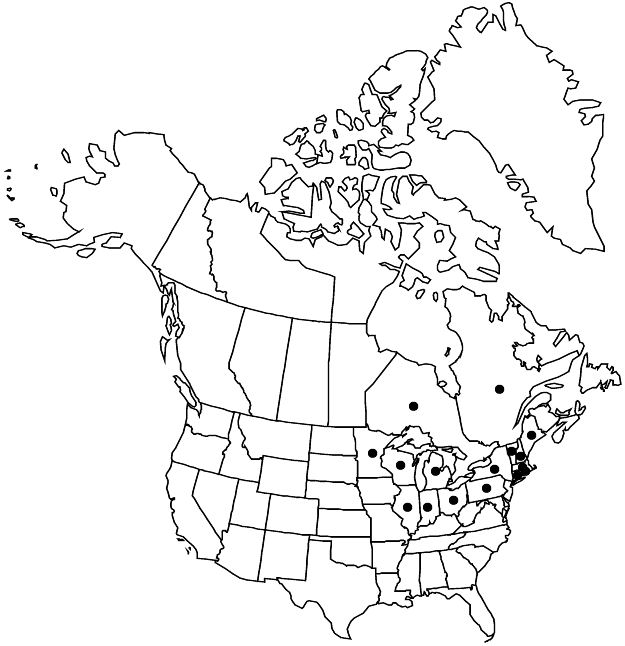Crataegus holmesiana
J. Elisha Mitchell Sci. Soc. 16: 78. 1900.
Shrubs or trees, 40–70 (–100) dm, single-trunked. Stems: twigs: new growth greenish to reddish, glabrous or pubescent; thorns on twigs recurved, often slender, 3–6 cm. Leaves: petiole length 30–35% blade, glabrate to densely hairy, often sparsely glandular; blade ± narrowly ovate, 6–9 cm, base cuneate or ± rounded, lobe apex acuminate, margins serrate or doubly serrate, teeth 2 mm, adaxial usually densely scabrous-pubescent young. Inflorescences: branches usually pubescent, rarely glabrous or tomentose. Flowers: hypanthium usually pubescent; stamens 5–8 (–10), anthers pink to rose-purple, sometimes crimson. Pomes bright to deep red, ellipsoid to broadly pyriform, 12–14 mm, usually glabrous; sepals widespreading or erose. 2n = 34, 51.
Phenology: Flowering May; fruiting Sep–Oct.
Habitat: Woodland edges, old pastures, fencerows
Elevation: 10–300 m
Distribution

Ont., Que., Conn., Ill., Ind., Maine, Mass., Mich., Minn., N.H., N.Y., Ohio, Pa., R.I., Vt., Wis.
Discussion
Crataegus holmesiana ranges from Wisconsin and Illinois through the southern Great Lakes region to southern Quebec and Maine, and to Pennsylvania; it is common in much of its range and should be expected in West Virginia.
In its usual form, Crataegus holmesiana is readily distinguished from C. coccinea vars. coccinea and pringlei, though occasional intermediates occur. Crataegus robesoniana Sargent [C. pedicellata var. robesoniana (Sargent) E. J. Palmer] is one and perhaps C. amicta Ashe [C. holmesiana var. amicta (Ashe) E. J. Palmer] is another. Crataegus holmesiana is routinely interpreted as a typical member of ser. Coccineae, thus, a villous inflorescence taxon with serrate sepals. However, the protologue by Ashe (authentic material not located) states that the inflorescences are glabrous and the sepals are nearly entire, causing confusion with C. tenuifolia Britton (ser. Tenuifoliae). Current usage for C. holmesiana became fixed after Ashe erected a var. villosa with serrate sepals and villous inflorescences.
Selected References
None.
Lower Taxa
"glabrate" is not a number."thin" is not a number."adnate" is not a number."dm" is not declared as a valid unit of measurement for this property.